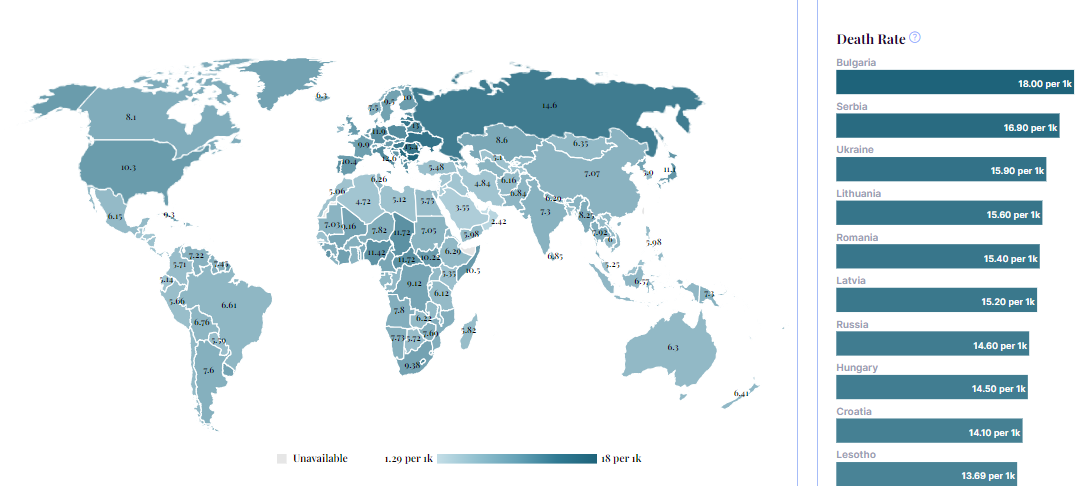In a world continuously undergoing rapid change and evolution, the question of mortality remains constant and undeniable. The answer to “How many people die each day in 2024?” may sound like a grim topic to explore.
However, understanding this figure can help contextualize global events, appreciate life’s fragility, and highlight the importance of various causes and effects leading to these numbers. In this blog post, I’ll get into the data, the reasons behind the numbers, and the implications of our current global mortality rate.
Demographic Breakdown of Daily Deaths
Understanding the global death toll requires a granular approach. When you break down the number of daily deaths by demographics such as age, gender, or location, you unveil a multi-layered story of humanity’s shared experience.
1. By Age

Children and elderly populations often face the highest mortality rates. Let’s explore the figures:
- Infants and Children: In many parts of the world, child mortality remains a significant concern. While great strides have been made, challenges persist.
- Infants: According to the World Health Organization, as of 2022, an estimated 5.2 million children died before reaching their fifth birthday, most from preventable causes. Extrapolating this data suggests a significant number of these deaths occur in infants.
- Children aged 5-14: The mortality rate significantly drops after the age of five, but deaths related to malnutrition, accidents, or diseases still persist.
- Elderly: With advancing age, the human body becomes more susceptible to various ailments and diseases.
- 65 and above: In research by the Centers for Disease Control and Prevention, older adults are more prone to chronic diseases, and this demographic witnesses a higher number of deaths daily.
2. By Gender

Gender can play a role in life expectancy and mortality rates due to biological, societal, and environmental factors.
- Males: Typically, males tend to have a slightly lower life expectancy compared to females. This gap can be attributed to a combination of biological differences, occupational hazards, and lifestyle choices.
- Risks: In research conducted by the World Bank, males globally are more likely to die from accidents, violence, and some non-communicable diseases than females.
- Females: While females generally live longer, they are not immune to specific health risks and societal pressures.
- Health Concerns: Women face unique health risks, including complications during childbirth. However, with improved healthcare and societal awareness, these risks have been on a decline.
Exact Numbers: Daily Deaths in 2024
A closer look at the exact figures for 2024 gives us a stark insight into the global mortality landscape. Here’s a breakdown:
According to the World Population Review, approximately 156,000 people die every day in 2024. This number is a culmination of various factors ranging from natural causes, diseases, accidents, and unforeseen events.
By Causes:

-
- Non-communicable diseases (NCDs): They remain the largest killer. About 41,000 daily deaths are due to cardiovascular diseases, while 21,000 are due to different types of cancers.
- Infectious diseases: Around 19,000 people succumb to respiratory infections daily. Diarrheal diseases claim approximately 11,000 lives each day, and the deadly malaria parasite causes over 2,000 deaths daily.
- Accidents and Violence: This category accounts for about 9,000 daily deaths, with road accidents, workplace incidents, and violent acts being significant contributors.
By Countries:

-
- India and China: Being the two most populous countries, they naturally record the highest number of daily deaths. India witnesses around 25,000 deaths daily, while China sees about 22,000 deaths. The majority of these deaths are due to NCDs, but both countries still grapple with communicable diseases.
- United States: With its aging population and high rates of NCDs, the US records approximately 7,500 deaths daily.
- African Continent: Countries like Nigeria, South Africa, and the Democratic Republic of Congo have a combined daily death toll of around 20,000, with a significant portion due to infectious diseases like HIV/AIDS, malaria, and waterborne diseases.
- European Union: The combined countries of the EU see about 14,000 deaths daily, with a large percentage due to age-related ailments and NCDs.
- Other countries: Regions like South America and Southeast Asia, when combined, account for the remaining deaths, with Brazil, Indonesia, and Pakistan being significant contributors.
Leading Causes of Daily Deaths
While the absolute number is essential, the causes behind these deaths provide a more comprehensive picture of global health and safety challenges.
1. Non-communicable Diseases (NCDs)
Chronic diseases are steadily becoming the leading causes of deaths worldwide.
- Cardiovascular diseases: Heart attacks and strokes primarily drive these numbers. Lifestyle changes, including diet and exercise, can significantly influence these figures.
- Numbers: According to the American Heart Association, cardiovascular diseases claim more lives each year than all forms of cancer and chronic lower respiratory disease combined.
- Cancers: With numerous types affecting different parts of the body, cancer remains a significant concern.
- Trends: As per the World Cancer Research Fund, cancer rates have been increasing globally, influenced by factors such as aging populations, changing lifestyles, and environmental factors.
2. Communicable Diseases
Infectious diseases continue to be a concern, especially in regions with limited healthcare access.
- Respiratory infections: Diseases like pneumonia and influenza remain leading causes of death in many parts of the world.
- Vaccination: In case study by the Our World In Data, vaccination campaigns have helped reduce mortality rates from some of these infections, but challenges persist.
- Diarrhoeal diseases: These diseases, often caused by contaminated food and water, have a significant death toll, especially among children.
Future Implications and Conclusion
The daily death toll is not just a statistic—it’s a reflection of our global community’s health, well-being, and the challenges we collectively face.
1. Impact on Global Population

As mortality rates fluctuate, they have direct repercussions on global demographics.
- Aging Population: If elderly populations experience lower mortality rates, we’ll see growth in this demographic, impacting everything from healthcare systems to global economies.
- Youthful Populations: In regions where child mortality rates are reducing, there will be a surge in the younger population, which can be both an asset and a challenge.
- Economic Challenges: In case study by the United Nations Department of Economic and Social Affairs, an aging population might lead to a reduced workforce, demanding a shift in economic strategies and potentially burdening social support systems.
- Opportunities and Challenges: A younger population indicates a potential boom in the workforce, innovation, and consumer markets. However, it also means a need for substantial investments in education and job creation.
2. Shaping Health Priorities
Understanding the primary causes behind daily deaths helps governments, NGOs, and communities shape health priorities.
- Preventive Care: A focus on prevention, be it through vaccinations, lifestyle education, or early detection, can dramatically reduce the number of daily deaths.
- Global Collaboration: According to the UNDP, collaborating on global health issues, sharing research, and pooling resources can accelerate the fight against both communicable and non-communicable diseases.
- Resource Allocation: Knowing which diseases or causes are leading to higher mortality can help in allocating resources more effectively, ensuring that funds and efforts are directed where they can make the most significant impact.
FAQs
What’s the average life expectancy in 2024?
In 2024, the global average life expectancy is approximately 73 years. However, this can vary significantly based on the country, region, and various socioeconomic factors.
How has the COVID-19 pandemic influenced the daily death rate?
The COVID-19 pandemic had a significant impact on global mortality rates, especially in 2020 and 2021. By 2024, with the advent of vaccines and treatments, the direct impact of COVID-19 on daily deaths has reduced, but its indirect effects on healthcare systems and economies continue to be felt.
Are natural disasters accounted for in these daily death statistics?
The figures provided are averages and might not account for sudden spikes in deaths due to natural disasters. Events like earthquakes, hurricanes, or tsunamis can cause sudden and significant increases in daily death numbers.
How do war and conflicts factor into these numbers?
Wars and conflicts can substantially influence daily death rates. The numbers provided consider ongoing conflicts, but sudden wars or escalations can drastically alter the statistics.
Are suicides included in these daily death figures?
Yes, suicides are included in the daily death statistics. Mental health remains a significant concern globally, and efforts are ongoing to address and reduce suicide rates.
What is the average number of deaths per day in 2024?
In 2024, the average number of deaths per day globally is approximately 156,000, based on estimates and the current population trends.
How many deaths are recorded per year in 2024?
Based on the daily average, the estimated number of deaths in 2024 is approximately 56.9 million.
How many people are projected to die in 2030?
Exact numbers for 2030 would require comprehensive modeling considering birth rates, aging populations, disease trends, and other factors. As of now, projections suggest a slight increase due to the growing global population, but exact figures would be speculative.
What is the biggest cause of death in the UK in 2024?
In 2024, non-communicable diseases, especially cardiovascular diseases and cancers, are the leading causes of death in the UK. It’s important to consult updated local health databases or the NHS for the most recent and specific data.
Globally, what is the most common cause of death each year?
Non-communicable diseases, particularly cardiovascular diseases, are the leading causes of death globally each year, followed by various types of cancers and respiratory diseases.
Final Words
In a rapidly changing world, understanding our mortality and its causes is not just a statistical endeavor but a reflection of humanity’s collective challenges and triumphs. By shining a light on these numbers, we are reminded of the areas needing urgent attention and the potential to effect meaningful change. As we navigate 2024 and the years beyond, let these figures inspire action, compassion, and a commitment to bettering global well-being.













